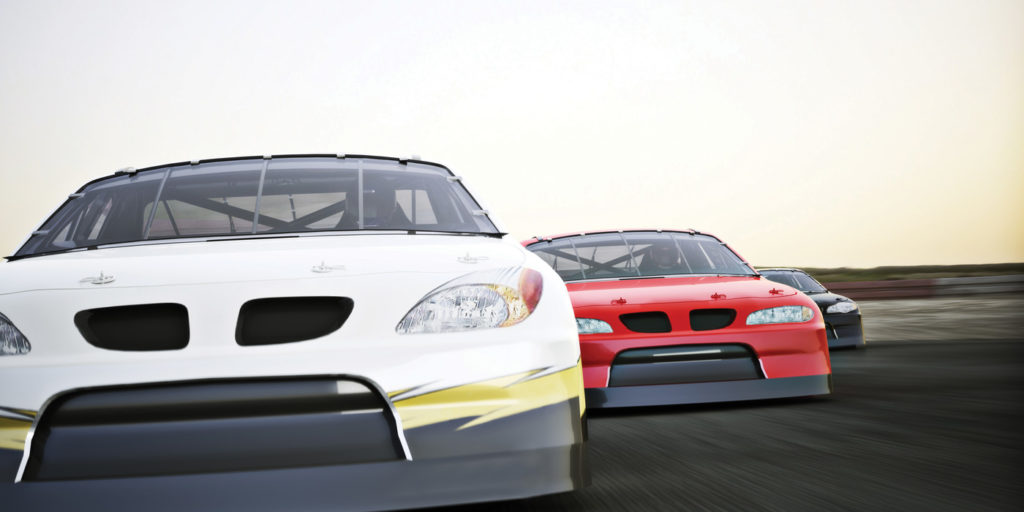No matter if it’s a 3,200-pound NASCAR or a 1,630-pound Indycar, the wheel bearings can help put a car in pole position and win a race. Racing teams are always looking for extra speed from the wheel bearings.
The first requirement for a wheel bearing is to have enough stiffness to resist deflection under cornering. A racing wheel bearing also must have the lowest possible friction. Friction between the seal and hub can eat up horsepower and kill top speed. Even a small improvement in a wheel-bearing design can yield extra power and speed.
Stiff Bearings
The first way to improve the stiffness of a wheel bearing is to increase the diameter and the distance between the inner and outer bearings. This approach works for both angular-contact spherical bearings and tapered roller bearings. The size of the rolling elements is another part of the equation. For racing angular-contact spherical bearings, the balls will be smaller, but there will be more balls or rollers compared to a road vehicle. Tapered roller bearings also will have a larger diameter, but the rollers are about the same size as a road vehicle. NASCAR specifies tapered roller bearings made of magnetic steel.
The rolling elements and races are heat-treated and polished to very exacting specifications. Some rollers and races use silicon nitride coatings to improve hardness and surface finish. The surface finish of the bearings has a direct relationship to the heat generated and the interaction with the grease. The lower the temperature inside the bearing means that the team might run a lower-viscosity grease.
Ceramic wheel bearings are used in some classes of racing, although both NASCAR and IndyCar forbid the use of ceramic bearings to reduce costs to the teams. Ceramic bearings are typically found on lighter vehicles like motorcycles and specific applications like drag racing.
The advantage of ceramic bearings is lower rolling resistance and less weight. Some applications like Formula car racing have started to use full-ceramic wheel bearings. Drag racers are starting to use them more for front wheels and in differentials.
Another technology driving ceramic wheel bearings is the growth of racing classes that use electric hybrid drive systems such as Formula One and some prototype sports car series. Electricity is bad for steel bearings. Stray electricity can arc between the rolling elements and races. This can cause pitting and the failure of the bearing. Since ceramic materials do not conduct electricity, they block the flow of electricity.
Wheel-Bearing Seals
Wheel-bearing seals on a production vehicle can produce a lot of friction. Road-car seals have to work under a wide variety of temperatures over a long life cycle. They have to keep the grease in and contaminants out.
The wheel-bearing seals on a race car like a NASCAR or IndyCar need to keep the grease in the wheel-bearing hub while creating the least amount friction. Longevity or endurance means the seal has to last to the end of the race. Most are designed to use positive pressure. As the temperature inside the hub increases, so does the pressure. The pressure seals the lip against the axle or spindle. Some wheel bearing seals have two pieces to reduce friction.
Grease
The grease for some racing wheel bearings is very special. IndyCar specifies the wheel bearing and seals for all the cars. But, in the rulebook, they specifically say the grease is open for development. Several IndyCar teams have partnered with lubricant manufacturers to formulate proprietary wheel-bearing greases to gain an advantage. NASCAR has the same open policy when it comes to wheel-bearing grease.
Next to the chemistry of the grease, one of the most researched areas is on the correct amount of grease needed inside the hub for the best protection and least amount of parasitic power loss. Many hours on chassis dynos have been spent to find the right amount.
At the top levels of motorsports, governing bodies are looking to contain costs and even the field for entertainment purposes. For some teams, just a small improvement of three horsepower or a few miles per hour at the end of the straight can mean the difference between a podium finish or stuck in the middle of the pack. Small improvements in wheel bearings can make all the difference.












